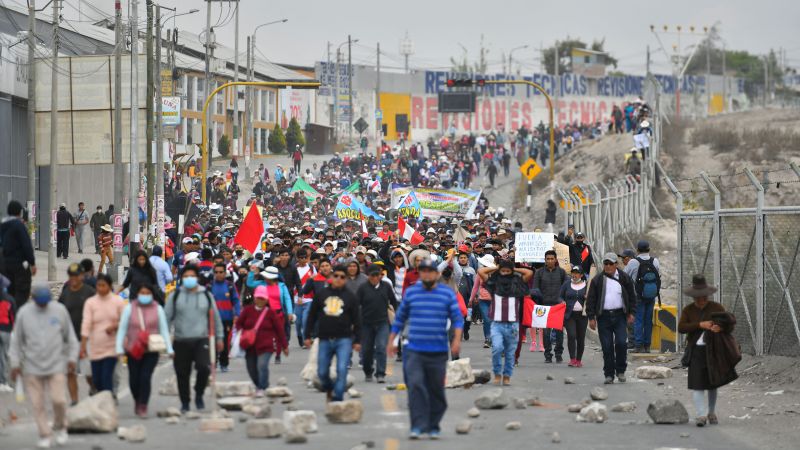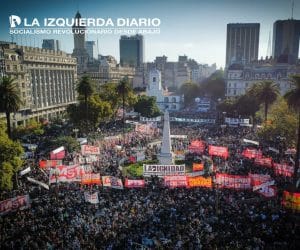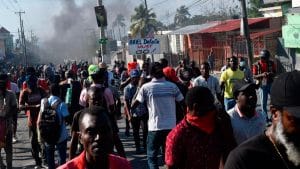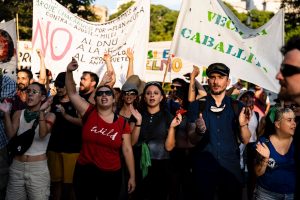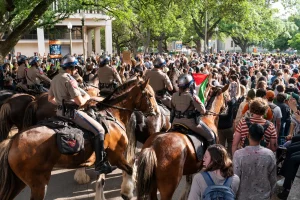Massive protests are developing in response to the parliamentary coup that removed Pedro Castillo from the presidency of Peru and allowed the rise of Dina Boluarte. This mass uprising, which is especially dynamic in poor and working-class neighborhoods, fundamentally challenges Boluarte’s presidency and the actions of parliament, as well as the judiciary and the media. It is the largest and deepest process of protests and crisis in years.
At the time of this article’s publication, Boluarte has ordered a state of emergency enforced through brutal police and military repression, especially in the areas of greatest resistance to the coup regime. Already the militarization has killed 28 protesters and wounded hundreds, mostly by direct fire from members of the repressive forces.
Failed Bonapartism, Parliamentary Coup d’État, and Peoples’ Response
On December 7, the Peruvian parliament was preparing to impeach President Pedro Castillo, the parliament’s third attempt at impeachment since Castillo’s election in 2021. The right-wing Congress’s previous attempts to impeach Castillo relied on a series of allegations that the former president had engaged in acts of corruption, appropriating public money to favor his family and members of his closest political clique.
The parliamentary far Right, made up of Fuerza Popular (Keiko Fujimori’s party), Renovación Popular (López Aliaga), among others, refused to recognize Castillo’s electoral victory, alleging fraud. These sectors, with the support of the mainstream press and later the Attorney General’s Office and the judiciary, carried out a well-synchronized media and legal campaign to show that the then president was running a “criminal network” and that he had to be removed from the presidency. This was an attempt by the Far Right to ignore the election results that led Castillo to the presidency. This is a parliamentary coup d’état planned from the first day that Castillo set foot in the Government Palace.
By December 7, this coup escalation had already advanced significantly. Former officials of Castillo, such as his former personal secretary, Beber Camacho, and his former head of the DINI (intelligence service), José Fernández Latorre, made public complaints that linked the former president with corruption scandals. On December 7, hours before the session to discuss the ousting of Castillo was to take place, Castillo’s former adviser, Salatiel Marrufo, provided televised statements from prison, implicating the former president in corruption.
All these allegations were aimed at breaking the congressional representatives who refused to vote for the coup attempt (87 votes were required). These maneuvers pushed Castillo to implement a failed Bonapartist attempt to close Congress and remove senior officials from the judiciary, the Attorney General Office, and the Constitutional Court. But Castillo’s move did not have the support of the armed forces and police, so his Bonapartist maneuver amounted to nothing more than a public speech. In response to Castillo’s move, many of his initial allies in parliament — such as those that made up the teachers’ bloc, those of Free Peru (Perú Libre), and New Peru (Nuevo Perú) — ended up supporting the impeachment. With this new parliamentary support for impeachment, the Far Right in parliament received more than the required 87 votes; in the end 101 representatives voted to remove Castillo. Immediately after the vote, the National Police arrested and imprisoned Castillo. Meanwhile, the Congress hastily swore in Boluarte as the new president.
What the sectors in government that implemented the coup and Boluarte herself did not expect was the mass spontaneous reaction to the coup. The day after Castillo’s dismissal, the anti-coup movement developed incrementally but forcefully through acts of protest against parliament and against the new president. The slogans of “out with everyone” and “new general elections” began to be voiced by the protesters, who, especially in the poorest regions of the interior of the country, began to stage protest marches and later began to blockade important highways, such as the Pan-American South at the height of the Ica region and in Chala-Arequipa. The North Pan-American Highway was also blocked, and in regions of the central highlands, as is the case of Apurímac, for example, the actions became much more forceful. Protesters even took over airports and burned important public institutions.
The Boluarte’s dictatorial government responded with repression, which, far from silencing the protesters, further inflamed spirits, especially when the first deaths occurred. The demonstrations spread to almost the entire country (on the fourth day of the struggle, in 20 of the 24 regions of Peru, there were road blocks, massive mobilizations, seizures of public spaces, etc.). Boluarte — who was sworn in to a cabinet of technocrats very close to power groups and big capitalists — decreed a state of emergency and ordered the intervention of the military. The repressive forces, shouting “kill or be killed,” savagely attacked the protesting population, killing about 30 people and injuring hundreds.
Today, a large part of Peru is militarized and in a state of emergency. Tanks, together with groups of soldiers and assault police, patrol the streets daily, seeking to intimidate the protesters and the people who come out to join them. The regime has even started labeling protesters “terrorists,” claiming that they belong to the extinct organizations from the 1980s, such as Sendero Luminoso and MRTA. Until recently, Peru was considered conservative and peaceful compared to Chile, Ecuador, and Colombia, all of which have seen powerful movements in recent years. What has prompted them to now stand up? What happened to what economists called the “Peruvian miracle” and the “triumph” of capitalism and neoliberalism?
Thirty Years of Neoliberalism: The Structural Roots of the Problem
Peru is a dependent capitalist country with markedly unequal development. For this reason, important academics say there are two Perus: One where the main political, administrative, commercial, financial, and productive activities are concentrated, where despite contradictions and inequalities typical of this system, there is a greater perception of progress and well-being. This sector is represented by the capital city of Lima. The other Peru, the one that historian Jorge Basadre calls the “deep Peru,” makes up most of the regions in country’s the interior. In this Peru there exist great social problems such as poverty, informal employment, and harshly concentrated unemployment, precariousness of social services, racial discrimination, etc. It is precisely this “deep Peru” that is the epicenter of this social uprising, which has revealed the crisis of the Peruvian state and society.
This crisis has been significantly enhanced by 30 years of neoliberalism. The authoritarian government of Alberto Fujimori implemented the neoliberal economic model after coming to power through the coup d’état of April 5, 1992. A year after the 1992 coup, the Fujimori regime imposed the 1993 Constitution, which remains Peru’s governing document to this day. The constitution created the legal conditions that favor the profits of large national and foreign businessmen to the detriment of the interests and needs of the working class, peasants, and popular sectors. After the implementation of the Constitution of 1993, a new political regime was launched that also promotes a precarious democracy, where the great majorities can only elect their representatives (president and Congress) every five years. After these elections, the masses watch elected officials abandon their campaign promises, as happened, for example, with Ollanta Humala and Pedro Castillo.
As a consequence of these 30 years of neoliberalism and the COVID-19 pandemic, Peruvians now live with a collapsed and underfunded health system, a public education system run by teachers living in precarity, and a lack of basic infrastructure. This model is also responsible for the high rate of informality and job insecurity, factors that big businesses use to increase their profit rate through intense exploitation.
It is on these material bases that the so-called Peruvian miracle is based. According to Peruvian Labor Market Performance by 2021, the latest report prepared by the company ComexPerú, the number of informal workers nationwide has risen to more than 13 million. This is an increase of 17.2 percent from 2020. As is known, from the reports of the National Institute of Statistics and Informatics (INEI), Peru’s informal employment rate (that is, without a contract and without rights)borders on 70 percent of the economically active population.
This high rate of labor informality is especially concentrated in the interior regions of the country. Eighteen regions have an informality rate higher than the national average. In particular, Huancavelica was the most affected, with a total of 285,677 informal jobs in contrast to only 15,700 formal jobs — an informality rate of 94.8 percent. Apurímac was in second place, with an informality rate of 90.6 percent. It is no coincidence, then, that most of the inland regions that present the highest rates of labor informality and poverty are also the regions where today the most forceful demonstrations of struggle against the Boluarte government and against the other state institutions are taking place.
Another of the sectors hard hit by the implementation of neoliberal policies is the countryside, which is precisely where all this social anger has been brewing. Today the peasants of the interior regions of the country — who basically carry out agricultural activities for their subsistence — are facing a serious crisis caused by the fall in the prices of their products. This is the result of the import of agricultural goods and the increase in the cost of inputs that are also imported, such as fertilizers. Large private mining investment — which is promoted as the lever of social development — deepens the crisis considerably with extractive activities that create sources of environmental contamination and appropriation of water resources. The consequences of extraction can be found in the high Andean zone of Moquegua with the Southern Mining Company or in the Apurímac and Cusco mining corridor with the Las Bambas Mining Company.
Organic Crisis and Racism
Adding to these structural elements is the deep crisis of state institutions, which have been overwhelming rejected by the populace. The executive, legislative, and judicial powers, as well as the political parties and the major media, are losing their hegemony and ideological control now that sectors of the population no longer feel represented by these institutions. This is what Antonio Gramsci called an “organic crisis.” For this reason, the masses see mobilization and struggle as the way to achieve their demands.
This generalized anger toward Congress and toward the parliamentary majority is a consequence of the deep devaluation of state power. The state is now seen as a sounding board for elite interests that have nothing to do with the needs of the people. This loss of faith in all the powers of the state began to develop since 2016.
The functions of the state underwent crisis in 2016 as a result of disagreements between the businessmen of the Odebrecht construction company and the politicians in charge at the time. The Odebrecht case was part of the Lava Jato operation, in which U.S. imperialism used the legitimate popular indignation against corruption in Peru as a way to get rid of governments and politicians that were not strong enough representatives of imperialist interests and stability. As a result of this fight between various sectors of the capitalist class, many former presidents and renowned political figures went to prison, and former president Alan García even committed suicide.
This crisis allowed parliament to become the stronghold of an important sector of the country’s so-called emerging bourgeoisie, made up mostly of provincial businessmen. Many of these capitalists built their fortunes as a result of illegal businesses or very lucrative but highly profitable educational companies that have scammed thousands of young people. These sectors, which at the time were led by Fujimorism, have made Congress the natural space to consolidate their businesses. They have a presence in Congress because many of these businessmen are in turn owners of political parties, such as the millionaire Cesar Acuña’s Alliance for Progress (Alianza para el Progreso), José Luna Gálvez’s We Can Peru (Podemos Perú), López Aliaga’s Popular Renovation (Renovación Popular), among others. There are other “company parties” with a longers history, but they are also stained with corruption and pro-business appeasement, as is the case of Popular Action (Acción Popular) of the also repressive Manuel Merino and the corrupt “Vitocho” Belaunde, as well as Popular Force (Fuerza Popular) of the infamous Keiko Fujimori.
Profound racism from these parties and institutions against the generally low-income indigenous population also contributes to the discrediting of the institutions and political parties, as well as their most recognized leaders. Ethnic-racial discrimination in Peru becomes a central element of the country’s political life, and it helps construct a hierarchical social order that marginalizes and excludes vast sectors of the population.
As the historian Alberto Flores Galindo would say, “Racism exists in Peru despite the fact that racial terms, suppressed in the procedures of public identification, have no official circulation. But a phenomenon that is covered up and even denied, does not stop being less real.” This racism, which has colonial roots and is very much a force in Peruvian society, has become an effective ideological tool used by the ruling classes to divide the exploited. And it is precisely against this naturalized and even institutionalized racism that many are mobilizing in the provinces of “deep Peru.”
Judicial Bonapartism and Parliamentary Coup d’État
The judiciary and the Attorney General’s Office are also part of the institutions challenged by the mobilized population. The way these institutions judicially attacked Pedro Castillo was very evident. The institutions were clearly unconcerned with seriously addressing corruption because while they went after Castillo, they did not go after other Peruvian leaders, many of whom were known to be engaged in corruption. The bodies in charge of administering justice in Peru are also highly discredited because it is well known that senior officials in this sector tend to collude with big business and politicians in exchange for perks.
Institutions like Peru’s judiciary and Attorney General’s Office maintain all-encompassing powers of intervening in political cases in Peru, even though these institutions are run by corrupt figures. The power of corrupt judicial institutions to intervene decisively in political cases is quite common throughout Latin America.
This is what we call judicial Bonapartism, and it means giving judges and prosecutors such power to the point of turning them into political arbitrators. According to Matías Maiello,
Judicial Bonapartism implies giving life to a judicial caste that asserts itself as a guarantor of bourgeois legality at the same time that it violates it to achieve its ends. A judiciary that intends, in the name of the rule of law, to assume a good part of the Bonapartist tendencies of the regime necessary to cope with the elements of political and economic crisis. An attempt to judicialize the increasingly pronounced struggle of interests to contain it within the bourgeois order.
And that is what was done recently in Peru as a result of the political intervention of Patricia Benavides, the attorney general. Benavides was the determining figure who, through her allegations and legal pressure, pushed and gave the “legal basis” to the parliamentary coup d’état that ended up dismissing Castillo. Benavides wielded this power even though she is being investigated owing to her closeness to her sister, who is linked to drug trafficking crimes.
Pedro Castillo and the Failure of the Reformist Strategy
Castillo won the presidency of Peru in 2021 amid the critical economic situation deepened by the COVID-19 pandemic. After the state and the traditional political parties lost legitimacy, Castillo won in an atmosphere in which racial slurs were commonly used to deride his campaign.
Many of those who voted for Castillo in the first and second rounds of the 2021 presidential elections did so with the hope that the Cajamarca teacher and unionist of rural origin, who had just led an important teachers’ strike in 2017, would have the strength and conviction to bring about progressive campaign promises. Importantly, Castillo’s campaign highlighted the need to change the 1993 Constitution through a Constituent Assembly and certain reforms to the neoliberal model.
But as soon as Castillo entered the Government Palace, he discarded his campaign promises. To maintain economic continuity, he placed the monetarist and neoliberal Julio Velarde in charge of the Central Reserve Bank. Castillo’s minister of economy renounced his promises to improve working conditions and continued with the austerity policy of previous administrations. Castillo traveled to the United States to speak in favor of attracting foreign investment, placing himself as the guarantor of respect for the legal conditions (1993 Constitution) that favor looting and plundering of Peru’s resources by imperialist multinationals.
Supporters of Castillo argue that there were no conditions for him to establish better policies, so it was correct for him to play it safe and not anger the bourgeoisie. Castillo supporters’ strategy was to take over — as much as possible — the institutions of the bourgeois state to try to manage capitalism from there in order to be able, later on, to carry out some reforms that do not bother the private sector.
For this reason, the reformists never called to fight for anything, not even when the parliamentary Right and the media attacked Castillo’s government and were building day by day the viability of the parliamentary coup d’état that ended up taking place on December 7. With each attack from the Right and the media, Castillo and his allies moved further to the right, to such an extent that they ended up calling the imperialist and pro-coup OAS as a lifeline. Yes, the same OAS that had just promoted the coup d’état against Evo Morales in Bolivia and that recognized the illegitimate government of Juan Guaidó in Venezuela.
The strategy of class conciliation and trying to manage the bourgeois state ended up leading Castillo to ruin. Pretending to make “changes” from within, without bothering the businessmen or moving in the slightest the institutionality of 93, became the determining factor that has now led him to share a cell in the same prison where Alberto Fujimori is.
Fight to Impose a Free and Sovereign Constituent Assembly
Despite Castillo’s betrayals of his campaign promises, the masses have taken to the streets, and neither bullets nor tanks, nor the state of emergency of the coup leader Boluarte, can subdue them in their fight. But as long as the people and the workers do not govern through their natural organizations, it will be impossible to concretize concretizing their demands. A step in this direction would be to get rid of the current political regime of 1993, and for this it is essential to fight for a Free and Sovereign Constituent Assembly that is born of worker and peoples’ mobilization and self-organization.
To achieve this, however, Peruvians must strengthen the only path in which workers and the oppressed can defeat the anti-democratic institutions: mass mobilization, to build a plan of struggle that culminates in the general strike to oust Boluarte and her entire regime, and then forge the workers’ and peoples’ alliance to conquer all demands. This is why the Socialist Workers Current (CST) calls for the establishment of a national Unitary Command of Struggle that allows the movement to centralize the various initiatives and strike as one fist.
Only the action of the class struggle in the streets and the self-organization in the path of the general strike can defeat the state of emergency and bring down the dictatorial government of Dina Boluarte. Only in this way will the movement impose a Free and Sovereign Constituent Assembly that responds to the needs of Peru’s oppressed and working class. Along this path, the impulse of workers’ and poor peoples’ organizations is necessary for this fight, and they will be the ones who will be able to lead a provisional government of the workers’ and poor people’s organizations that convenes a Constituent Assembly, as a transition to a government of the workers.
To change things at the root, Peruvians cannot wait for this Congress or the next one to convene the Constituent Assembly. No, only the spaces for worker and peoples’ self-organization, forged in the heat of the struggle, are a guarantee of victory. There is strength, and the masses continue to express it daily in the streets. The movement must advance to a higher struggle to bring down the regime of 1993 and conquer our aspirations.


